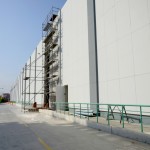Throughout human history, symbols have played a crucial role in conveying complex ideas such as stability, protection, and continuity. These symbols serve as visual anchors that reinforce societal values, spiritual beliefs, and cultural identities. Among the most enduring of these is the Djed Pillar, an ancient Egyptian symbol representing stability and resilience. By exploring its origins, symbolism, and modern interpretations, we can better understand how such icons influence both ancient and contemporary perceptions of security and endurance.
- 1. Introduction: Understanding Stability and Protection in Ancient and Modern Contexts
- 2. The Cultural and Mythological Foundations of the Djed Pillar
- 3. The Djed Pillar as a Symbol of Structural and Social Stability
- 4. The Concept of Protection Embedded in Symbols and Rituals
- 5. The Eye of Horus: An Illustration of Symbolic Protection in Modern Times
- 6. From Myth to Science: Understanding Stability and Navigation in Nature
- 7. Material and Technological Aspects of Symbols and Their Preservation
- 8. The Non-Obvious Depths: Symbolic Interconnections and Their Psychological Impact
- 9. Conclusion: The Enduring Power of Symbols of Stability and Protection
1. Introduction: Understanding Stability and Protection in Ancient and Modern Contexts
Stability and protection are fundamental concepts that resonate across cultures and eras. In ancient societies, symbols such as the Djed Pillar conveyed these notions visually, serving both spiritual and societal functions. Today, these ideas persist, often reflected in modern symbols and rituals. Recognizing the significance of these symbols helps us understand how humans strive for continuity amid change. Symbols act as visual language, transmitting values and fostering collective resilience, whether through the steadfastness of a stone pillar or the vigilant gaze of an eye.
The Djed Pillar, originating in ancient Egypt, exemplifies this enduring human desire for stability. Its form and symbolism have transcended millennia, influencing both spiritual practices and cultural identities. To fully appreciate its significance, it is essential to explore its origins and how it encapsulates the universal human pursuit of enduring stability and protection.
2. The Cultural and Mythological Foundations of the Djed Pillar
a. Origins in ancient Egyptian mythology and religion
The Djed symbol’s roots trace back to ancient Egyptian mythology, where it served as a vital emblem of stability and continuity. Its earliest appearances are found in funerary texts and temple reliefs dating back to the Old Kingdom (around 2686–2181 BCE). The symbol was associated with the god Osiris, the ruler of the afterlife, embodying eternal life, resurrection, and resilience. Over time, the Djed became a universal icon representing the backbone of Osiris, symbolizing strength and endurance essential for both spiritual salvation and societal stability.
b. The symbolism of the Djed as the backbone of Osiris and its spiritual significance
In myth, Osiris’s resurrection depended on his spinal column—the Djed—symbolizing the core of life and stability. This connection highlights the Egyptian view that physical and spiritual resilience are intertwined. The Djed was often depicted as a pillar with horizontal bars, representing the vertebrae, emphasizing its role as a structural support. Rituals involving the Djed aimed to invoke protection, renewal, and eternal life, illustrating how mythological symbols served practical spiritual functions.
c. Connection between mythological stability and societal cohesion
The mythological significance of the Djed extended beyond individual spirituality to societal cohesion. It represented the stability of the cosmos, the divine order (Ma’at), and the Pharaoh’s role as the guarantor of harmony. Temples and monuments often featured the Djed to reinforce the idea that social and spiritual stability were interconnected. This symbol served as a reminder that societal resilience depended on adherence to divine principles, much like the backbone supports the body.
3. The Djed Pillar as a Symbol of Structural and Social Stability
a. Architectural representations in ancient Egyptian monuments
Architecturally, the Djed symbol appears in temple pylons, obelisks, and funerary architecture, often carved or painted to embody strength. The design’s stability is reflected in its vertical form and horizontal bars, symbolizing a resilient foundation. These representations were not merely decorative but served as visual assertions of societal endurance, reinforcing the idea that Egypt’s spiritual and political order was rooted in divine stability.
b. The role of symbols like the Djed in reinforcing social order and continuity
In addition to architecture, the Djed was central in religious rituals that symbolized societal stability. Priests carried Djed images during ceremonies to invoke divine support for the pharaoh and the nation. Such rituals emphasized continuity, reinforcing the social contract and the divine right of rulers. The enduring presence of the Djed in public and sacred spaces underscored its importance in maintaining social cohesion through shared spiritual symbols.
c. How the Djed reflects the Egyptian pursuit of eternal stability
For the Egyptians, eternal stability was a divine ideal. The Djed symbol encapsulated this aspiration, representing an unbreakable core that sustains life and order. Its frequent depiction in tombs and temples was a reminder that spiritual and societal stability required ongoing reverence and adherence to divine principles. Today, such symbols remind us that stability—whether personal, societal, or spiritual—is often rooted in enduring values and collective continuity.
4. The Concept of Protection Embedded in Symbols and Rituals
a. The protective function of symbols in rituals and daily life
Symbols like the Djed and the Eye of Horus served not only as representations of stability but also as protective talismans. In rituals, they were believed to ward off evil, ensure safety, and invoke divine favor. Everyday objects, amulets, and ceremonial artifacts often bore these symbols, embedding protection into daily life. This practice underscores how ancient cultures integrated spiritual symbols into routines to maintain harmony and security.
b. The Eye of Horus as a modern example of protective symbolism
Transitioning into modern times, the zur Eye of Horus Seite exemplifies how protective symbols continue to influence contemporary culture. Originally representing vigilance, health, and divine protection, the Eye of Horus now appears in jewelry, logos, and branding, symbolizing safety and watchfulness. Its enduring presence highlights the universal human desire for protection, bridging mythological significance with modern symbolism.
5. The Eye of Horus: An Illustration of Symbolic Protection in Modern Times
a. Origins and meaning of the Eye of Horus in Egyptian mythology
The Eye of Horus, also known as Wadjet, originates from Egyptian myth where Horus’s eye was injured and subsequently restored, symbolizing healing, protection, and restoration. It was considered a powerful amulet against evil, embodying vigilance and divine watchfulness. The eye’s intricate design represented the phases of the moon, linking it to cycles of renewal and stability.
b. How the Eye of Horus has been used historically and in modern branding
Historically, the Eye of Horus was a common protective amulet worn by Egyptians and placed in tombs to safeguard the deceased. Today, its symbolism extends into fashion, logos, and even digital media, where it continues to signify vigilance, health, and protection. Its widespread recognition demonstrates how ancient symbols adapt to modern contexts while retaining their core meanings.
c. The connection between Eye of Horus and concepts of vigilance and health
The Eye of Horus encapsulates the human desire for watchfulness and well-being. Its symbolism of vigilance aligns with modern health practices, where awareness and protection are central. Whether in ancient amulets or contemporary branding, the Eye continues to evoke a sense of safeguarding against harm, illustrating the timeless nature of protective symbols.
6. From Myth to Science: Understanding Stability and Navigation in Nature
a. Scarab beetles navigating using the Milky Way as a celestial compass
Nature offers remarkable examples of stability and navigation. The scarab beetle, revered in ancient Egypt, demonstrates biological navigation by using the Milky Way’s position as a celestial compass. This natural behavior echoes the Egyptian reliance on stars for timekeeping and stability, illustrating how biological systems and cosmic phenomena underpin survival and societal organization.
b. Egyptians’ identification of constellations for timekeeping and stability in agriculture
Egyptians meticulously observed the night sky, identifying constellations that signaled seasonal changes vital for agriculture. These celestial markers provided a stable framework for planting and harvesting cycles, ensuring societal stability. This cosmic order, reflected in their mythology and symbols like the Djed, underscores the deep connection between natural rhythms and human stability.
c. How natural navigation and timekeeping exemplify biological and cosmic stability
Both biological navigation (as seen in animals like beetles and birds) and cosmic timekeeping (through star observations) exemplify systems built on stability. These natural processes inspire human symbols and rituals, emphasizing a universal pursuit to understand and emulate the stability inherent in nature and the cosmos.

 Centro Empresarial El Nuevo TRIGAL
Centro Empresarial El Nuevo TRIGAL  proyectos@mmgsa.com
proyectos@mmgsa.com  (+51) 01 273-0641
(+51) 01 273-0641 






